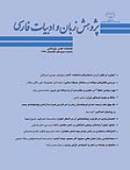مقایسة ویژگیهای حماسی دو منظومة برزونامه (بخش کهن) و هماینامه
محورهای موضوعی : پژوهشهای ادبیات کلاسیک ایران
حمید جعفری قریه علی
1
![]() ,
دکتر سید علی قاسمزاده
2
,
علی نجمایی
3
,
دکتر سید علی قاسمزاده
2
,
علی نجمایی
3
1 - ادبیات و علوم انسانی
2 - ادبیات و علوم انسانی
3 -
کلید واژه: حماسه خصایص حماسی سبکشناسی برزونامه هماینامه,
چکیده مقاله :
در تاریخ آفرینش آثار ادبی فارسی، نوع ادبی حماسه موقعیتی محوری دارد. برزونامه و همای نامه، دو اثر از آثار موجود در جریان حماسهسرایی فارسیاند که به دلیل قرار گرفتن در سیر جریان یادشده و بازتاب روح حماسی حاکم بر جامعة ایرانی و بازشناسی هویت ملّی ایرانیان در برهههای تاریخی قرون ششم تا هشتم هجری شایسته توجّه اند. این پژوهش به شیوهای توصیفی- تحلیلی در تلاش است ضمن واکاوی ارزشهای این دو اثر از منظر حماسهسرایی، به مقایسه و تحلیل عناصر حماسی موجود در آنها بپردازد و میزان تطبیق آن دو را با مختصات حماسی آشکار سازد. بنا بر نتایج این پژوهش، خلق آثار یادشده را باید متأثّر از فضای رقابتی ادبیات کلاسیک فارسی دانست و نوآوری سرایندۀ برزونامه در غیر منتظره و خلاف آمد نشان دادن پایان داستان و همچنین نوآوری سرایندة هماینامه در موضوع، نشان از قرار گرفتن در چنین فضای رقابتی است. به ویژه هماینامه که مختصات حماسی آن متناظر با دگرگونیهای فکری و ادبی سبک عراقی، به دلیل تلفیق با مضامین عاشقانه و غنایی به غثّ و سمین گرفتار شده است. بنابراین در ارزش گذاری مقایسهای، منظومة برزونامه در مقابل هماینامه به دلایلی چون تبعیّت از سنّت حماسهسرایی ملّی که قهرمانان اصلی اش را از خاندان رستم برمیگزیند، افتخار به نژاد و اصالت خانوادگی و ملّی، دغدغههای بومی و گاه رویکرد ملّیگرایانه در کنشهای قهرمانان داستان و تقابل با نیروهای بیگانه، توانسته است خصایص حماسی خود را با شدّت و ضعف در محورهای عرضی و طولی اثر نمودار سازد و در بخشهایی به قدرت و اقتدار حماسی فردوسی نزدیک کند.
The literary genre of epic has a pivotal role in the history of creating literary Persian works. Burzo-name and Homay-name are two available works from Persian epic composing current that are considerably important due to their being within the above current and their representation of dominant epic spirit on Iranian society and recognition of national Iranian identity in historical periods of 6th to 8th centuries Hegira. The study method is descriptive-analytic and attempts to investigate the values of these two works from the perspective of epic-composing, and compares and analyzes the available epic components within them and shows their adaptation with epic features. Based on the results of this study, one can consider the creation of abovementioned works as affected by the competitive atmosphere of Persian Classic Literature and innovation of Burzo-name composer in “Unexpected” and “Incompatible” shows the end of story and also innovation of Homay-name composer in “subject” shows being in such a competitive environment. Particularly, Homay-name whose epic feature is correspondent with intellectual and literary changes of Araqi Style is involved with eloquent and non-eloquent speech due to compilation with lyric and romantic themes. Therefore, in comparative valuation, the Burzo-name epopee could have shown its epic features in longitudinal and latitudinal axes of the work in comparison with Homay-name due to reasons like following tradition of national epic-composing whose heroes are selected from Rostam family, honor in race and family and national originality, and local problems and sometimes national approach toward heroic actions of the story and contrasting with foreign forces and it could have closed them toward the epic power and dominance of Firdausi.


